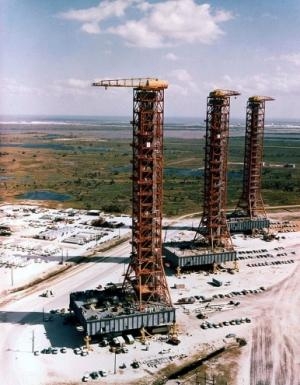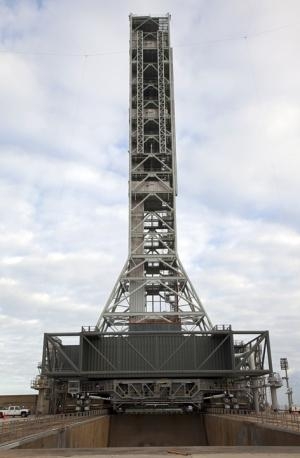Half A Billion Tax Payer Dollars Recovered From The Waste
Basket
By: Wes Oleszewski
On July 24th, 1965, at NASA's Kennedy space Center, a crawler
transporter moved and Apollo Mobile Launcher for the first time. In
this first test the crawler transporter moved the Mobile Launcher
exactly 1,749 yards. At that point the test was stopped to allow
evaluation of the move. In the days that followed technicians
discovered pieces of steel and, more importantly, pieces of brass
laying along the crawlerway. The discovery of these metal fragments
led to the discovery of 14 tapered roller bearings that had been
damaged on the crawler itself. This unexpected damage stopped all
testing and left the crawler transporter and the Mobile Launcher
parked on the crawlerway until further notice.
LUTs During Apollo Days

In short order the problem found its way into the news media.
For the first time widespread doubts concerning the Apollo program
began to sprout from Florida to Washington DC. Even the iconic
Walter Cronkite spoke about it on his evening newscast as he told
his audience that the crawler transporter and Mobile Launcher were
sitting on wooden blocks under the Florida sun and no one was sure
if they would ever move again. Of course the problems were solved,
the crawler transporters did move again and the three Mobile
Launcher’s served the United States space program for the
next four and one half decades supporting Apollo, Skylab, ASTP and
finally- as Fixed Service Structures- two of them tended to
the Space Shuttle.
With the conception of the Constellation program NASA determined
that a new generation of Mobile Launcher was needed. Construction
of the new Mobile Launcher began with delivery of the first major
components to KSC in February of 2009. This new 390 foot tall
mobile launcher was intended to support the Aries I launch vehicle.
On February 1, 2010, however, the Obama administration sent to
Congress its FY2011 budget proposal which contained no funding for
the Constellation program. With that the Ares launch vehicles and
all related hardware were subsequently defunded. Yet the contract
for the construction of the Mobile Launcher remained running and
the launcher was basically completed by August 2010. Then there it
sat, outside of the Vehicle Assembly Building (VAB) having no
vehicle to support until the Congress could undo the Obama FY2011
NASA budget proposal.
Much like Cronkite back in 1965 many in the current news media
attempted to make an example of the Constellation Mobile Launcher
in order to call into question the future of NASA's human
spaceflight program. One very popular commentator, who is a friend
of mine, made a habit of asking guests what they thought about that
"B.W.M. (Big Waste of Money) out there sitting by the VAB." This
would seed some conversation concerning NASA's human spaceflight
program and its future. Of course in today's modern news media
spicy conversation often trumps reasonable examination. The fact is
that supposed big waste of money actually could not become a big
waste of money until it was actually scrapped. With that in mind
the United States Congress was determined that in its rebuke of the
Obama FY2011 NASA budget they it would protect as much of the money
invested in the Constellation program as possible. Those "sunk
costs" included hardware such as the new Mobile Launcher.
LUT Today

In the summer of 2011 the information came out that NASA planned
to use the Constellation Mobile Launcher as the mobile launcher for
the new Space Launch System. A reasonable examination of the Mobile
Launcher finds that although the structure outwardly looks like a
complete launch tower it is in fact little more than a framework.
None of the critical equipment that would make it vehicle specific
has yet been installed. Thus, the new Mobile Launcher can easily be
adapted to almost any launch vehicle. By way of this reasonable
examination NASA has now breathed new life into the Mobile Launcher
and successfully pulled some $500 million out of the Obama
administration’s wastebasket.
Just after 10:00 am on the 16th of November this year a crawler
transporter lifted and moved a Mobile Launcher and its Launch
Umbilical Tower for the first time since the early 1980s. At that
familiar snail’s pace so often seen as the crawler
transporters move spaceflight hardware, the new Mobile Launcher was
taken out to Lunch Complex 39B. In testing reminiscent of the early
days of Apollo the Mobile Launcher was being run through a series
of compatibility tests and checks. After two weeks on the pad the
Mobile Launcher was again lifted and slowly rolled back to its
parking place near the VAB. Although overlooked by most in the
media this simple test was a milestone in the process of undoing
the Obama administration’s myopic cancellation of America's
program to return to the moon. As I write this, I'm looking at my
computer screen and watching by way of the Internet while a half a
billion tax payer dollars are rescued from the Obama
administration's waste-can as the new Mobile Launcher rolls
smoothly along the crawlerway at the Kennedy Space Center.
What was once condemned as a "BWM" is now back on track to
become a critical piece of hardware in America's effort to explore
space beyond low Earth orbit. (Images courtesy NASA)
 ANN's Daily Aero-Linx (05.02.24)
ANN's Daily Aero-Linx (05.02.24) ANN's Daily Aero-Term (05.02.24): Touchdown Zone Lighting
ANN's Daily Aero-Term (05.02.24): Touchdown Zone Lighting Aero-News: Quote of the Day (05.02.24)
Aero-News: Quote of the Day (05.02.24) ANN FAQ: Contributing To Aero-TV
ANN FAQ: Contributing To Aero-TV NTSB Final Report: Cirrus Design Corp SR20
NTSB Final Report: Cirrus Design Corp SR20




